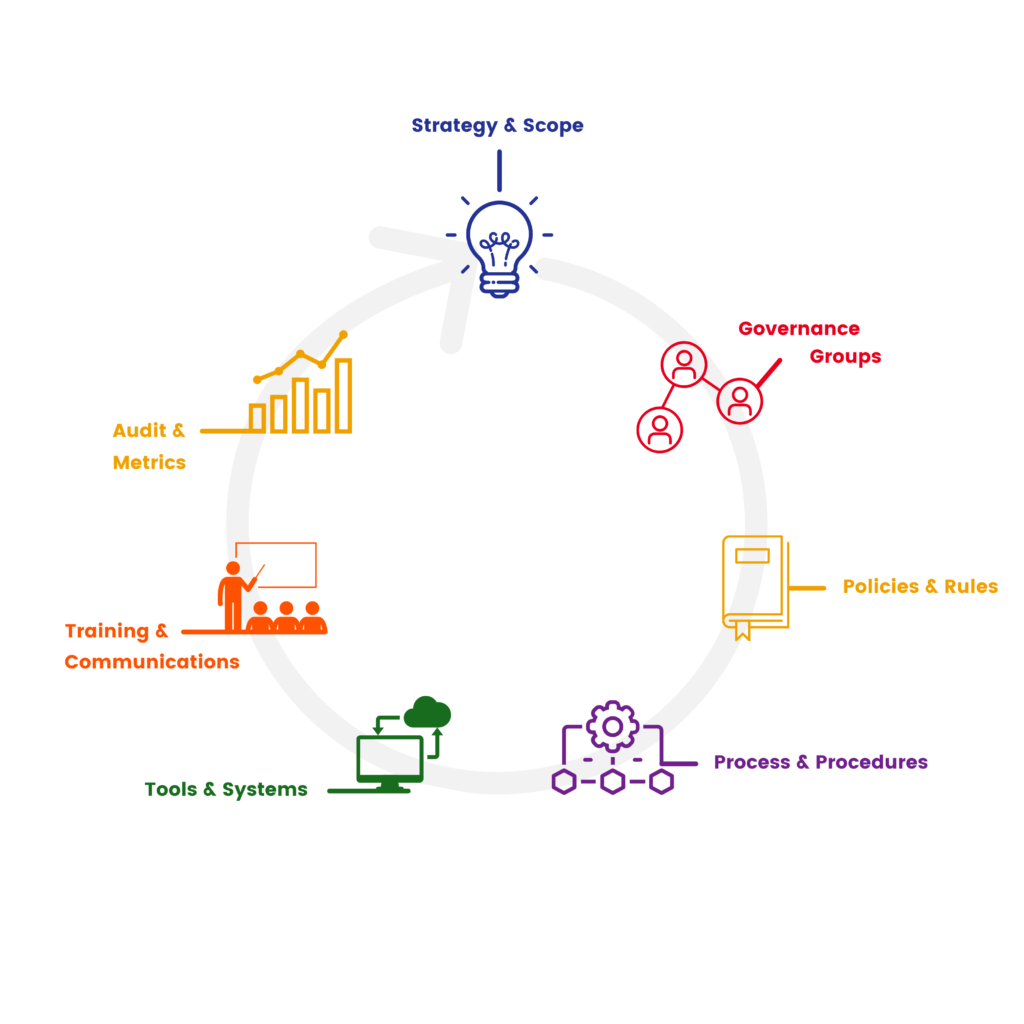15 Oct A Governance Model for Boosting Business Value
Good governance is never a one-and-done effort. That would be like planting an orange tree in your backyard, patting yourself on the back, and then expecting it to take care of itself.
But if you ask any seasoned gardener, they will tell you it’s going to take more than just the initial set-up if you want to actually enjoy that home-grown fruit.
Like an orange tree, your information governance (IG) program isn’t going to take care of itself. And if you ask any seasoned IG professional – like one of Access Sciences’ consultants, they will tell you it’s going to take a lot more than the initial set-up if you want to boost business value.
Luckily, we’re here to help!

FOLLOWING BEST PRACTICES: ACCESS SCIENCES’ 7-POINT GOVERNANCE MODEL
Access Sciences’ 7-Point Governance Model guides all our IG projects, tailoring best practices to each client’s unique industry, needs, and culture. This model, which represents a continuous process, can be applied to derive the most business value out of your information.
Here’s how:
-
- Strategy & Scope
In this first step, we encourage IG professionals to establish a vision that supports your organization’s mission and goals. And then, look at your available resources, determine your priorities, and focus on them.
It’s easy for IG programs to take on too much and stall. To help with this, we recommend adopting a risk-based approach, which will help you remain strategic in prioritizing those IG program elements.
Beginning with the end in mind sets you up for program success from the outset. This step can include a Records & Information Management (RIM) Assessment to reveal your current program’s strengths, issues, risks, needs, and more.
-
- Governance Groups
Next, you’ll want to establish groups across the organization and define the roles they’ll play. The groups you need will ultimately depend on your organization’s current structure and culture, but common groups include legal, risk management, information technology (IT), compliance/legal, and operations.
This step should start with executive support, which can be a “make it or break it” factor since strong governance programs require ownership and leadership from the earliest stages.
Good governance is never a one-and-done effort. That would be like planting an orange tree in your backyard, patting yourself on the back, and then expecting it to take care of itself.
But if you ask any seasoned gardener, they will tell you it’s going to take more than just the initial set-up if you want to actually enjoy that home-grown fruit.
Like an orange tree, your information governance (IG) program isn’t going to take care of itself. And if you ask any seasoned IG professional – like one of Access Sciences’ consultants, they will tell you it’s going to take a lot more than the initial set-up if you want to boost business value.
Luckily, we’re here to help!

FOLLOWING BEST PRACTICES: ACCESS SCIENCES’ 7-POINT GOVERNANCE MODEL
Access Sciences’ 7-Point Governance Model guides all our IG projects, tailoring best practices to each client’s unique industry, needs, and culture. This model, which represents a continuous process, can be applied to derive the most business value out of your information.
Here’s how:
-
-
-
- Strategy & Scope
-
-
In this first step, we encourage IG professionals to establish a vision that supports your organization’s mission and goals. And then, look at your available resources, determine your priorities, and focus on them.
It’s easy for IG programs to take on too much and stall. To help with this, we recommend adopting a risk-based approach, which will help you remain strategic in prioritizing those IG program elements.
Beginning with the end in mind sets you up for program success from the outset. This step can include a Records & Information Management (RIM) Assessment to reveal your current program’s strengths, issues, risks, needs, and more.
-
-
-
- Governance Groups
-
-
Next, you’ll want to establish groups across the organization and define the roles they’ll play. The groups you need will ultimately depend on your organization’s current structure and culture, but common groups include legal, risk management, information technology (IT), compliance/legal, and operations.
This step should start with executive support, which can be a “make it or break it” factor since strong governance programs require ownership and leadership from the earliest stages.
“The risk-based approach does two critical things at once. First, it designates risk reduction as the primary goal… Second, the program distills top management’s risk-reduction targets into precise, pragmatic implementation programs with clear alignment from the board to the front line. Following the risk-based approach, a company will no longer ‘build the control everywhere’; rather, the focus will be on building the appropriate controls for the worst vulnerabilities, to defeat the most significant threats—those that target the business’s most critical areas.”
-
- Policies & Rules
This step is meant to establish principles that the organization must follow, balancing the need for privacy and security based on your culture and regulatory landscape.
The four primary principles for governance (across all industries) are:
-
-
-
-
- Information must be managed as an asset
- Formal accountability must be in place
- Information must be compliant with regulatory controls
- Information quality must be defined and managed consistently across its lifecycle
-
-
-
-
- Processes & Procedures
After defining your policies and rules, you’ll want to turn them into processes and procedures for your organization. These should guide how governance groups conduct their work and interact with data consumers.
This will emphasize your measured approach to IG, and your users will be assured that the governance in place is fair and balanced.
-
- Tools & Systems
Data maps, metadata glossaries, workflows, and data analytics are all tools that will support different parts of your data lifecycle.
Data maps in particular will enable a thorough understanding of the enterprise architecture, which is critical to a successful IG program. It provides a deep understanding of where information is kept, how it flows through the organization, and what current tools and systems are in use.
In addition, tools and systems should be sustainable and scalable as your organization grows and your needs change. And it’s important to find tools and systems that support your processes – not drive them.
For example, if your content management system is not designed and configured with your specific information landscape in mind, it won’t be able to (right out of the box) manage your records the way you need it to.
-
- Training & Engagement
To maximize your governance program’s success, you need to inspire a data-driven culture. And the best way to do this is to train early and communicate often.
For your governance groups, identify the skills, knowledge, and abilities they need to perform their new roles successfully. For your data consumers and producers, train them on how to use data, how to share data, how to create data, and how to manage data.
It’s not sufficient to train once and expect great results. Once training is over, keep people engaged through communication – regularly update on the status of the program and/or reinforce key takeaways from training.
-
- Audit & Metrics
The last step in our 7-Point Governance Model is to set up audits and metrics that will monitor, evaluate, and improve your IG program.
Again, good governance isn’t a one-and-done effort. So, improving should be a continuous process through regular compliance audits, security assessments, and data quality audits.
While our 7-Point Governance Model is a solid outline for any IG program, it won’t reach a high level of success until it’s tailored to your organization’s unique industry, needs, and culture.
NEXT STEPS
Since 1985, Access Sciences’ team of experts have coupled IG best practices with industry expertise to address our clients’ unique information needs. If you’re looking to start or refresh your IG program, kick off with Step 1: Strategy & Scope with an RIM assessment!



